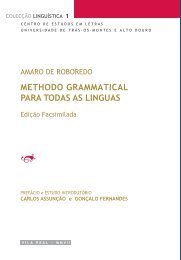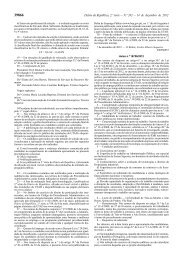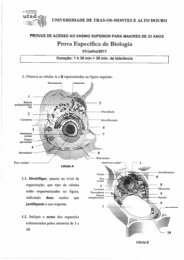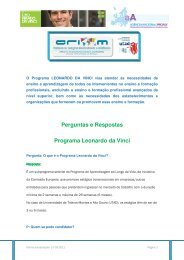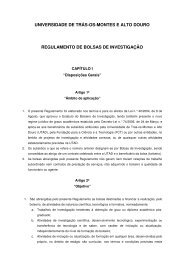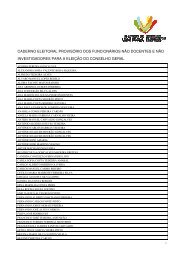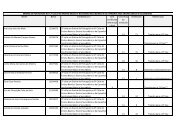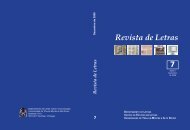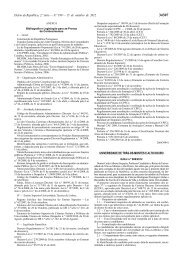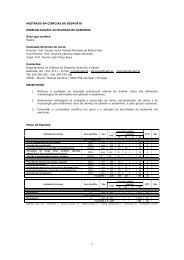Revista de Letras - Utad
Revista de Letras - Utad
Revista de Letras - Utad
You also want an ePaper? Increase the reach of your titles
YUMPU automatically turns print PDFs into web optimized ePapers that Google loves.
From the Bible to Cosmopolitan… 133<br />
After this brief sojourn throughout history, this paper aims to offer a<br />
preliminary exploration of the socialization of women through the study of the<br />
WOMAN AS CHICKEN metaphor in wi<strong>de</strong>ly read teenage and women’s<br />
magazines such as Cosmopolitan, Vanity Fair, Nineteen or CosmoGirl. For this<br />
purpose, the “GREAT CHAIN OF BEING” metaphor (Lakoff & Turner 1989)<br />
along with ethnobiological (Wierbizcka 1996, Martsa 1999, 2003),<br />
anthropological (Leach 1979) and cultural classifications of animals (Harris<br />
1985) will be used as a framework for the study of the metaphorical uses of<br />
chick and hen in these sort of publications. This will be followed by an analysis<br />
of a corpus of linguistic metaphors extracted from teenage and women’s<br />
magazines, which are then discussed in relation to language and socialization.<br />
II. - From the Bible to Cosmopolitan<br />
Before <strong>de</strong>aling with the metaphor un<strong>de</strong>r discussion, a preliminary note<br />
about the title of the article needs to be ma<strong>de</strong>. As the rea<strong>de</strong>r may have noticed,<br />
“From the Bible to Cosmopolitan” reflects the wi<strong>de</strong> span of time in which the<br />
WOMAN AS CHICKEN metaphor has evolved in Western culture. Yet, at the<br />
same time, it also tries to be a humorous remark about the influence of this<br />
women’s magazine in our society, especially from a feminine perspective. In<br />
fact, having been <strong>de</strong>fined as “the Bible for women” (Gauntlett 2002, Gough-<br />
Yates 2003, Machin 2005), the magazine Cosmopolitan erected as the advocate<br />
of women’s rights at the time when women, having achieved suffrage, were<br />
leaving the traditional domestic sphere and roles of mother and wife to enter the<br />
work market, gaining, therefore, personal as well as financial in<strong>de</strong>pen<strong>de</strong>nce<br />
(Gauntlett 2002). In the struggle for self-<strong>de</strong>finition, the so-called “women’s<br />
magazines” started to proliferate to cater for the needs of what was labeled as<br />
“the new woman” (Nicholas & Price 1998, Gough-Yates 2003). Woman’s Own,<br />
Vogue, Vanity Fair, Marie Claire and Cosmopolitan, among many others,<br />
helped women make sense of their collective experiences by providing mo<strong>de</strong>ls<br />
for women to follow. The pages of these publications covered a wi<strong>de</strong> selection<br />
of topics ranging from trivial issues such as make-up tricks to more serious<br />
concerns affecting women’s health through fashion articles, sexual relations,<br />
cooking, dieting, travelling, parenting or job-seeking.<br />
The circulation of these publications gradually increased and women’s<br />
magazines started to expand their rea<strong>de</strong>rship by targeting a new audience:<br />
teenagers. In fact, adolescents, who began to enjoy quite a lot of money and<br />
leisure time, provi<strong>de</strong>d a rich market for the media. Mo<strong>de</strong>led upon the versions of<br />
the more mature women’s magazines, spin-off publications such as CosmoGirl,<br />
You or Nineteen started to proliferate with a very similar goal, namely, to<br />
provi<strong>de</strong> mo<strong>de</strong>ls for teenagers to follow.




